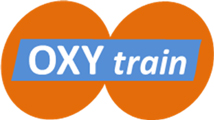Network organisation
OXYTRAIN management structure
To ensure the implementation of the research and training programmes as well as the supporting transfer of knowledge, a specific management structure has been designed for the project. This management structure will ensure the effective management of the ESRs training (including training through research), but it will also ensure that the ESRs participate actively throughout the management structure in order to develop the skills of future team leaders.
Consortium management: The coordinator (Prof. Marco Fraaije (RUG) will act as intermediary between the partners and the European Commission.
Supervisory board: The OXYTRAIN project will be managed by a Supervisory Board (SB), comprised of one representative from each of the 10 consortium partners, plus 3 representatives of the ESRs, and representatives from associated partners. The SB is the decision-making body of the consortium for strategic decisions impacting on the project and its external relationship, in particular with the European Commission.
ESR Training Manager (ETM): The ETM (Prof. Andrea Mattevi, UNIPV) will ensure the quality and coherence between the training performed at different locations and between work packages. This will assure the close involvement of each individual ESR in their planning of the training execution.
ESR Supervision Committees (ESC): The ESC for each ESR will comprise the main supervisor, the secondment co-supervisor (when applicable from non-academic partners), and a third academic co-supervisor. Regarding the 3 students recruited by non-academic partners, the ESC will include a main supervisor from the companies, another main supervisor from the university awarding the degree (RUG for both ESR3 and ESR9, and RWTH for ESR6), and a co-supervisor from academia. The ESC’s main objective is to ensure that the ESR sets realistic and effective targets on the path to the overall project objectives, meets those targets, and acquires the training in scientific and transferable skills that will enable them to go and be effective scientists in their selected area.
ESR Committee: All ESRs will be members of an independent committee, which will be a forum for discussions among the ESRs. It will draft and present proposals to the SB conveying the views of, and suggested strategic innovations from the ESRs.
Scientific Advisory Board (SAB): The SAB will have 3 members of which 2 will come from industry. The major function of the SAB will be to comment critically on the research and training activities of the ETN, and suggest new directions where appropriate.
